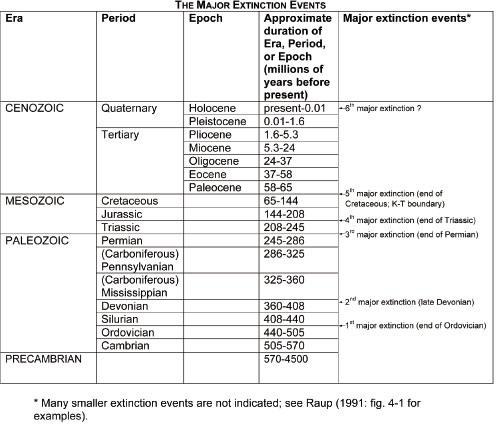Extinction (the complete
disappearance of a species from Earth) is an important part of
the evolution of life on Earth. The current diversity of species
is a product of the processes of extinction and speciation
throughout the previous 3.8 billion year history of life. Raup
(1991 [link]) assumed that there might be 40
million species alive today, but between 5 and 50 billion
species have lived at some time during the history of the
Earth. Therefore, Raup estimated that 99.9% of all the life that
has existed on Earth is now extinct); a species is assumed to be
extinct when there is no reasonable doubt that the last
individual has died (IUCN, 2002 [link]).
However, extinction has not occurred at a constant pace through
the Earth’s history. There have been at least five
periods when there has been a sudden increase in the rate of
extinction, such that the rate has at least doubled, and the
extinctions have included representatives from many different
taxonomic groups of plants and animals; these events are called
mass extinctions. The timing
of these mass extinctions is shown in Figure 16.1.
Each of the first five mass extinctions shown in Figure 16.1 represents a significant loss of biodiversity
- but recovery has been good on a geologic time scale. Mass
extinctions are apparently followed by a sudden burst of
evolutionary diversification on the part of the remaining
species, presumably because the surviving species started using
habitats and resources that were previously "occupied" by more
competitively successful species that went extinct. However,
this does not mean that the recoveries from mass extinction have
been rapid; they have usually required some tens of millions of
years (Jablonski, 1995 [link]).
It is hypothesized that we are currently on the brink of a
"sixth mass extinction," but one that differs from previous
events. The five other mass extinctions predated humans and
were probably the ultimate products of some physical process
(e.g. climate change through meteor impacts),
rather than the direct consequence of the action of some other
species. In contrast, the sixth mass extinction is the product
of human activity over the last several hundred, or even several
thousand years. These mass extinctions, and their historic and
modern consequences are discussed in more detail in the modules
on Historical perspectives on extinction and
the current biodiversity crisis, and Ecological
consequences of extinctions..
Raup, D.M. (1991). Extinction: bad genes or bad luck? New York, New York, U.S.A.: W.W. Norton and Co.
[IUCN] International Union for the Conservation of Nature and Natural Resources. (2002). UCN Red List of Threatened Species. [Available from: http://www.redlist.org (accessed March 11, 2003)].
Jablonski, D. (1995). Extinctions in the fossil record. In J.H. Lawton and R.M. May (Eds.), Extinction rates. (pp. 25-44). Oxford, U.K.: Oxford University Press.
- Extinct
a species is assumed to be extinct when there is no reasonable
doubt that the last individual has died (cite-titleIUCN, 2002 [m12157-iucniucnlink])
Extinction
the complete disappearance of a species from Earth
Mass extinction
a period when there is a sudden increase in the rate of
extinction, such that the rate at least doubles, and the
extinctions include representatives from many different
taxonomic groups of plants and animals




